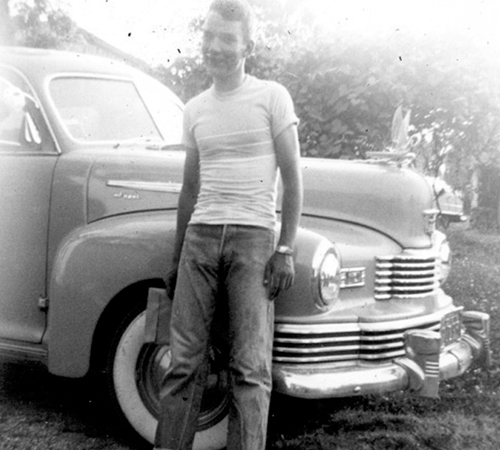It was a hot night a few weeks ago and, after a supper of corn on the cob and sweet Nancy’s delicious Swiss steak, I was sitting on the front porch enjoying a slightly chilled glass of Pinot Noir and watching the traffic on Route 45.
Do you know — I saw absolutely zero cars with white wall tires!
Sixty years ago, if your car didn’t have white walls, you were a stodgy old stick-in-the-mud (like my Dad). At 16, my first car, a well-used 1940 Dodge didn’t have them, but somehow I organized a set of Port-A-Walls, that, although they stood a little proud of the tires at speed, simulated white walls pretty well.
My next car, a 1948 Nash, had real white wall tires and I spent a lot of time with a brass-bristled wire brush. Although I sometimes bought a product called Bleche-White, which was especially for cleaning white walled tires, I found that cheaper Old Dutch, BAB-O or Comet cleanser, worked just as well. Even in the winter, when it was difficult to wash the whole car, my buddies and I still managed to keep the wheels and tires of our cars clean.
Why white?
Back in the earliest days of rubber tires, the whole tire, tread and all, was white. Most of us think of rubber as being black, but natural rubber is sort of off-white. So when tires first began to be made from the stuff, they were white as well.
The white rubber, however, wasn’t very durable, being especially susceptible to deterioration caused by the sun. Chemists discovered that by mixing carbon black into the natural rubber, it increased durability and traction while turning the rubber black.
At first, only the tread of the tire was made of carbonized rubber and both the inner and outer sidewalls remained white. But, all black tires came to be thought of as more durable, and the white sidewalls were covered with a thin layer of black rubber making them more desirable and much easier to keep clean.
Improvements, rationing
Sometime during the early 1920s, balloon tires, which afforded a softer ride, were developed. The much wider sidewalls of these tires made them more prominent and, while they looked cool on a light-colored car, the owners of darker painted machines began to ask for white sidewalls again in order to contrast with the dark paint and gleaming chrome that became prevalent in the late ’20s and 1930s.
Then, in the 1930s, cars were lowered on the chassis, fender openings were made smaller and fender skirts were introduced by automobile designers, making the inside sidewall difficult to see. This led to single sided whitewall tires which were quite popular until World War II.
During that conflict, when the supply of natural rubber from the southwest Pacific dwindled, and the military made heavy demands on the rubber industry, most people were just happy to have any old tires on their cars. So long as they held air, the color of the sidewalls mattered not a bit.
Not on his car
I mentioned my Dad earlier as not being a whitewall enthusiast. As long as I can remember, until he bought a new car sometime in the 1960s, he never had a whitewall tire on one of his cars, except during the war years.
At one time, I remember his old Cadillac, which had huge tires — 7.50X16s, I think — wore a single whitewall tire; he had picked it up used somewhere and was all he could get.
After tires and cars became plentiful again after the war, the demand for the decorative tires boomed, even though they were a little more expensive. Those, like me, who couldn’t afford new tires, made do with porta-walls, or even white tire paint — which wasn’t very satisfactory at best.
Curb jobs
Remember curb feelers? The biggest bugaboo to whitewall tires was parallel parking — scrape a sidewall against a curb and there was an ugly black mark on the pristine whiteness of your tire.
To prevent this, many people, including me, installed curb feelers — thin spring wires about six or eight inches long that clamped to the lower edges of your right fenders and (hopefully) scraped the curb — to give an audible warning when a tire was close enough.
Sometime around 1960, in an effort to make cars look lower, a new tire was introduced that had a white stripe about an inch or so wide in the center of the black sidewall. Most even had a raised ridge of black rubber around the outside of the white stripe to protect it from pesky curbs, although a good hard hit could still cause damage.
Other variations included two or three even narrower white stripes, or a red and a white stripe or a lone red one.
Out of fashion again. By the 1980s, whitewalls had fallen out of favor and are rarely seen today, except on antique or classic cars. Most folks in these hurried days can’t find the time to scrub scuffed tires and besides, whitewalls just aren’t cool anymore.
(Send comments or questions to Farm and Dairy, P.O. Box 38, Salem, OH 44460-0038.)













